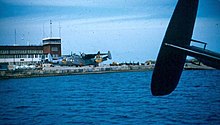Naval Air Station Bermuda Annex
|
Naval Air Station Bermuda Annex Naval Operating Base Bermuda; Naval Station Bermuda; Naval Air Station Bermuda |
|
|---|---|

U.S. Coast Guard PBM-5Gs at NAS Bermuda in the 1950s.
|
|
| Summary | |
| Airport type | Military |
| Owner | U.S. Government (lease) |
| Operator | United States Navy |
| Location | Morgan's Point (formerly Tucker's Island, Morgan's Island, and part of Great Bermuda Island, in Sandy's Parish, Bermuda. |
| Built | April 1941 - March 1942 |
| In use | 1942 - 1970 (it lost its air squadron in 1965) |
The United States Navy's Naval Operating Base was a seaplane base in Bermuda, the original Naval Air Station Bermuda. Following the US Navy's take over of Kindley Air Force Base (subsequently retitled NAS Bermuda), the base was adapted to other uses as an annex to the new NAS Bermuda, the NAS Annex. Following the end of the Cold War, the base was closed in 1995, along with other US Naval, Royal Naval, and Canadian Armed Forces facilities in Bermuda.
Prior to American entry into the Second World War, an agreement was arranged between the governments of British Prime Minister Winston Churchill and U.S. President Franklin D. Roosevelt for the loan of a number of obsolete, mothballed ex-US Naval destroyers to the Royal Navy and the Royal Canadian Navy, in exchange for which the USA was granted 99-year base rights in a number of British West Indian territories. This Destroyers for Bases Agreement, a forerunner of the Lend-Lease Agreement, had the sleight-of-hand effect of placing the defence of those territories in the hands of the neutral USA, allowing British forces to be sent to the sharper ends of the War.
Although not part of this exchange, Churchill also granted the US similar base rights in Bermuda and Newfoundland, however no destroyers or other war material were received by Britain in exchange. The grants came as a surprise to the Colonial Government, when US engineers arrived in 1940 to begin surveying the colony for the construction of an airfield that was envisioned as taking over most of the West End of the Island. Frantic protests by the Governor and local politicians led to those plans being revised. The US Army would build an airfield at the North of Castle Harbour. The US Navy would build a flying boat station at the West End. The US Navy began initial operation of Anti-submarine patrols by floatplanes operating from the Royal Air Force station on Darrell's Island. Its own base opened in 1941 as the Naval Operating Base, but was initially a construction site.
...
Wikipedia
